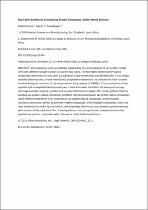 ResearchSpace
ResearchSpace
Flax fabric reinforced arylated soy protein composites: A brittle-matrix behaviour
JavaScript is disabled for your browser. Some features of this site may not work without it.
- ResearchSpace
- →
- Research Publications/Outputs
- →
- Journal Articles
- →
- View Item
| dc.contributor.author |
Kumar, R

|
|
| dc.contributor.author |
Anandjiwala, RD

|
|
| dc.date.accessioned | 2012-02-14T09:37:40Z | |
| dc.date.available | 2012-02-14T09:37:40Z | |
| dc.date.issued | 2012-05 | |
| dc.identifier.citation | Kumar, R and Anandjiwala, RD. 2012. Flax fabric reinforced arylated soy protein composites: A brittle-matrix behaviour. Journal of Applied Polymer Science, vol. 124(4), pp 3132-3141 | en_US |
| dc.identifier.issn | 0021-8995 | |
| dc.identifier.uri | http://onlinelibrary.wiley.com/doi/10.1002/app.35374/pdf | |
| dc.identifier.uri | http://hdl.handle.net/10204/5564 | |
| dc.description | Copyright: 2012 Wiley. This is an ABSTRACT ONLY | en_US |
| dc.description.abstract | Biocomposites were successfully prepared by the reinforcement of soy protein isolate (SPI) with different weight fractions of woven flax fabric. The flax-fabric-reinforced SPI-based composites were then arylated with 2,2-diphenyl-2-hydroxyethanoic acid (DPHEAc) for 4 h to obtain arylated biocomposites. A new method was proposed to determine the amount of carbon dioxide evolved during the arylation of the soy protein in the presence of DPHEAc. Characterizations of the arylated and nonarylated biocomposites were done by Fourier transform infrared spectroscopy, thermogravimetric analysis, and dynamic mechanical thermal analysis. The results indicate that the arylated soy-protein-based composites exhibited mechanical behavior like brittle-matrix composites, which differentiated them from nonarylated soy-protein-based composites, which showed mechanical behavior similar to polymer–matrix composites. In the arylated composites, there was clear evidence of a stick–slip mechanism, which perhaps dominated and, therefore, prevented easy deformation of the reinforced film. Scanning electron microscopy studies revealed cracks in the arylated soy protein composites when they were subjected to tensile tests. | en_US |
| dc.language.iso | en | en_US |
| dc.publisher | Wiley | en_US |
| dc.relation.ispartofseries | Workflow;8066 | |
| dc.subject | Biopolymers | en_US |
| dc.subject | Flax fabric | en_US |
| dc.subject | Reinforced flax fabric | en_US |
| dc.subject | Woven flax fabric | en_US |
| dc.subject | Soy protein isolate (SPI) | en_US |
| dc.subject | Polymer science | en_US |
| dc.subject | Polymer–matrix composites | en_US |
| dc.subject | Brittle-matrix behaviour | en_US |
| dc.subject | Biocomposites | en_US |
| dc.subject | Polymers | en_US |
| dc.title | Flax fabric reinforced arylated soy protein composites: A brittle-matrix behaviour | en_US |
| dc.type | Article | en_US |
| dc.identifier.apacitation | Kumar, R., & Anandjiwala, R. (2012). Flax fabric reinforced arylated soy protein composites: A brittle-matrix behaviour. http://hdl.handle.net/10204/5564 | en_ZA |
| dc.identifier.chicagocitation | Kumar, R, and RD Anandjiwala "Flax fabric reinforced arylated soy protein composites: A brittle-matrix behaviour." (2012) http://hdl.handle.net/10204/5564 | en_ZA |
| dc.identifier.vancouvercitation | Kumar R, Anandjiwala R. Flax fabric reinforced arylated soy protein composites: A brittle-matrix behaviour. 2012; http://hdl.handle.net/10204/5564. | en_ZA |
| dc.identifier.ris | TY - Article AU - Kumar, R AU - Anandjiwala, RD AB - Biocomposites were successfully prepared by the reinforcement of soy protein isolate (SPI) with different weight fractions of woven flax fabric. The flax-fabric-reinforced SPI-based composites were then arylated with 2,2-diphenyl-2-hydroxyethanoic acid (DPHEAc) for 4 h to obtain arylated biocomposites. A new method was proposed to determine the amount of carbon dioxide evolved during the arylation of the soy protein in the presence of DPHEAc. Characterizations of the arylated and nonarylated biocomposites were done by Fourier transform infrared spectroscopy, thermogravimetric analysis, and dynamic mechanical thermal analysis. The results indicate that the arylated soy-protein-based composites exhibited mechanical behavior like brittle-matrix composites, which differentiated them from nonarylated soy-protein-based composites, which showed mechanical behavior similar to polymer–matrix composites. In the arylated composites, there was clear evidence of a stick–slip mechanism, which perhaps dominated and, therefore, prevented easy deformation of the reinforced film. Scanning electron microscopy studies revealed cracks in the arylated soy protein composites when they were subjected to tensile tests. DA - 2012-05 DB - ResearchSpace DP - CSIR KW - Biopolymers KW - Flax fabric KW - Reinforced flax fabric KW - Woven flax fabric KW - Soy protein isolate (SPI) KW - Polymer science KW - Polymer–matrix composites KW - Brittle-matrix behaviour KW - Biocomposites KW - Polymers LK - https://researchspace.csir.co.za PY - 2012 SM - 0021-8995 T1 - Flax fabric reinforced arylated soy protein composites: A brittle-matrix behaviour TI - Flax fabric reinforced arylated soy protein composites: A brittle-matrix behaviour UR - http://hdl.handle.net/10204/5564 ER - | en_ZA |





